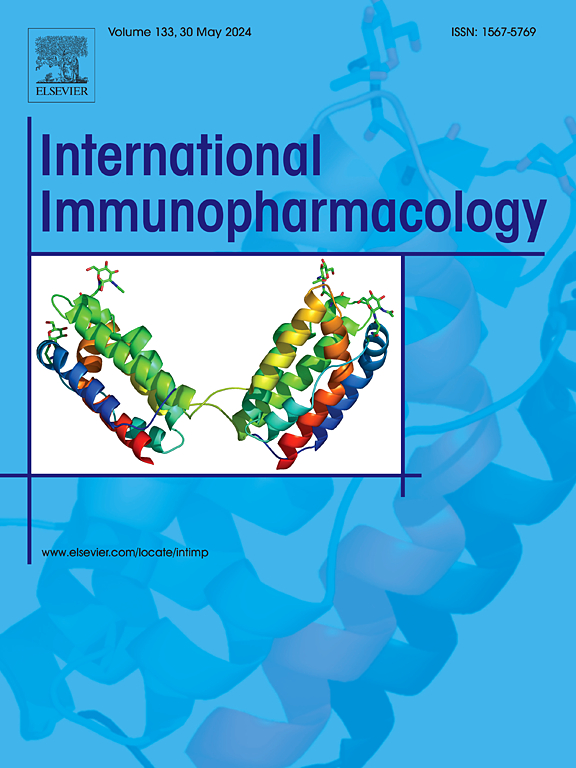Electroacupuncture normalized tumor vasculature by downregulating glyoxalase-1 to polarize tumor-associated macrophage to M1 phenotype in triple-negative breast cancer
IF 4.8
2区 医学
Q2 IMMUNOLOGY
引用次数: 0
Abstract
Background
Triple-negative breast cancer is a particularly aggressive type of breast cancer that is closely associated with abnormal vascularization within the tumor. However, traditional anti-VEGF therapies and other treatments have limited efficacy. Tumor-associated macrophages (TAMs) induce and regulate tumor angiogenesis. In recent years, regulating TAMs polarization has become a hot topic for research with objectives to normalize tumor vasculature and improve drug delivery and the tumor microenvironment. Our previous studies have found that peritumoral electroacupuncture (EA) can regulate tumor angiogenesis, but the underlying mechanism remains unclear.
Methods
In this study, we examined the phenotype of TAMs and inflammatory factors to observe the effect of peritumoral electroacupuncture on the phenotypic polarization of TAMs. Based on this, we evaluated the structure and function of tumor vasculature. Finally, we conducted a preliminary exploration of the mechanism underlying the regulation of TAMs phenotypic polarization by peritumoral electroacupuncture.
Results
In this study, we found that peritumoral electroacupuncture could promote the phenotypic polarization of TAMs toward the M1 type, thereby reducing microvascular density in tumor tissue, increasing pericyte coverage, improving the stability of the basement membrane, promoting vascular maturation, and enhancing perfusion while reducing tissue hypoxia.
Conclusions
Peritumoral electroacupuncture can promote the phenotypic polarization of TAMs toward the M1 type, leading to normalization of tumor vascular structure and function. The mechanism may be related to the downregulation of glyoxalase-1 and subsequent activation of the MGO-AGEs/RAGE axis.

在三阴性乳腺癌中,电针通过下调乙二醛酶-1使肿瘤相关巨噬细胞极化为M1表型而使肿瘤血管正常化。
背景:三阴性乳腺癌是一种特别具有侵袭性的乳腺癌,与肿瘤内异常血管化密切相关。然而,传统的抗vegf疗法和其他治疗方法的疗效有限。肿瘤相关巨噬细胞(TAMs)诱导和调节肿瘤血管生成。近年来,调控tam极化已成为研究热点,其目的是使肿瘤血管系统正常化,改善药物传递和肿瘤微环境。我们之前的研究发现肿瘤周围电针(EA)可以调节肿瘤血管生成,但其机制尚不清楚。方法:本研究通过检测tam的表型和炎症因子,观察瘤周电针对tam表型极化的影响。在此基础上,我们对肿瘤血管的结构和功能进行了评价。最后,我们对肿瘤周围电针调控tam表型极化的机制进行了初步探讨。结果:在本研究中,我们发现瘤周电针可促进tam向M1型表型极化,从而降低肿瘤组织微血管密度,增加周细胞覆盖,提高基底膜稳定性,促进血管成熟,增强灌注,同时减少组织缺氧。结论:瘤周电针可促进TAMs向M1型表型极化,使肿瘤血管结构和功能正常化。其机制可能与glyoxalase-1的下调和随后MGO-AGEs/RAGE轴的激活有关。
本文章由计算机程序翻译,如有差异,请以英文原文为准。
求助全文
约1分钟内获得全文
求助全文
来源期刊
CiteScore
8.40
自引率
3.60%
发文量
935
审稿时长
53 days
期刊介绍:
International Immunopharmacology is the primary vehicle for the publication of original research papers pertinent to the overlapping areas of immunology, pharmacology, cytokine biology, immunotherapy, immunopathology and immunotoxicology. Review articles that encompass these subjects are also welcome.
The subject material appropriate for submission includes:
• Clinical studies employing immunotherapy of any type including the use of: bacterial and chemical agents; thymic hormones, interferon, lymphokines, etc., in transplantation and diseases such as cancer, immunodeficiency, chronic infection and allergic, inflammatory or autoimmune disorders.
• Studies on the mechanisms of action of these agents for specific parameters of immune competence as well as the overall clinical state.
• Pre-clinical animal studies and in vitro studies on mechanisms of action with immunopotentiators, immunomodulators, immunoadjuvants and other pharmacological agents active on cells participating in immune or allergic responses.
• Pharmacological compounds, microbial products and toxicological agents that affect the lymphoid system, and their mechanisms of action.
• Agents that activate genes or modify transcription and translation within the immune response.
• Substances activated, generated, or released through immunologic or related pathways that are pharmacologically active.
• Production, function and regulation of cytokines and their receptors.
• Classical pharmacological studies on the effects of chemokines and bioactive factors released during immunological reactions.

 求助内容:
求助内容: 应助结果提醒方式:
应助结果提醒方式:


